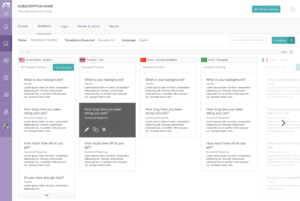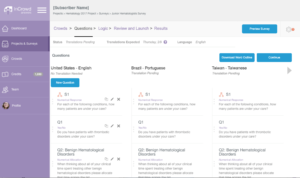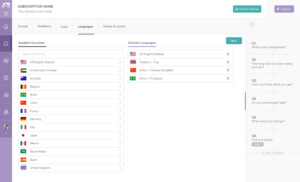
The side-by-side view of questions allows users to make variation-specific edits and check them in context.

Wireframe prototype showing all the steps of authoring a global survey, previewing it, and viewing results
My role
UX Lead, working with a freelance UI designer, two front end developers, and one backend developer.
Activities
- Task analysis
- Information architecture exploration
- Wireframing
- Moderated, remote usability testing
- Detailed screen design
About InCrowd
InCrowd provides tools and services for rapid market research in the healthcare industry.
The problem / opportunity
InCrowd had been known for its flagship microsurvey platform, which is available to market researchers as a self service SaaS tool as well as a full service offering. Some of our full service clients had been asking us to perform international surveys on their behalf. The opportunities were valuable, but the process for our client service team to fulfill these projects was laborious and involved much copying and pasting. We saw this as an opportunity to reduce some time and effort (and the potential for errors) for our client service team and pave the way for a self service tool for these projects as a new revenue stream.
Information architecture approaches
Our client service team members would start with a “master” survey and then split it into country-language variations.
We explored a few ways of organizing each country and language survey variation and whether to include a representation of the “master” survey (from which all the others are propagated) in the UI. See various folders in the early wireframe prototype for the alternatives.
Through a round of usability testing with our client service team, we learned that they often needed to adjust parts of the survey (before translation) sent to a specific country language in situations where a drug is not available in that country or there is some cultural difference that needs to be accommodated. When doing this, the team found it useful to view a list of questions for each country-language variation side-by-side before sending the survey for translation. Also, presenting content of the “master” survey throughout the project opened the potential for confusion if a team member made edits to a specific country-language variation and then made conflicting edits to the “master”, so we removed the “master” survey content from view once a survey was split into variations.
The solution
We allowed our client service team to start with a standard survey and then convert it to a “parallel survey” so that they can be flexible as client requests arise for in-progress work. See this task flow diagram for the primary workflow. This wireframe prototype walks through all steps of survey authoring and previewing. We carried out the side-by-side view to every step in survey authoring, and I worked with our UI designer to detail out some of the screens in this InVision prototype for selecting a language and authoring a global survey. Results will appear under tabs separated by country/language variation.
Not shown was the API integration with a translation partner to translate outgoing surveys and incoming open-ended responses and comments.
Removing bottlenecks and potential errors for our client service team increased our capacity for this work and made the engagements much more profitable. Later, we will evaluate the potential for a fully self-service global survey offering.
